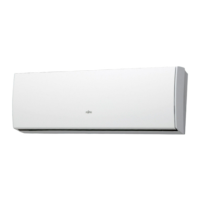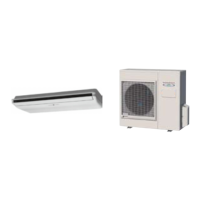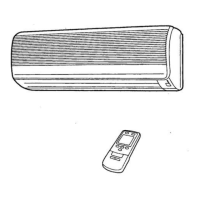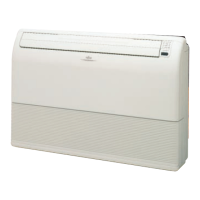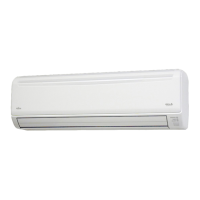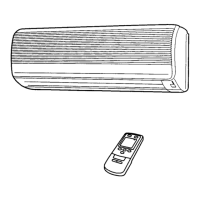3
STANDARD PARTS
The following installation parts are furnished. Use them as required.
INDOOR UNIT ACCESSORIES
Name and Shape
Cover plate (left)
Cover plate (right)
Tapping screw (ø4 × 10)
Installation template
Bracket (left)
Bracket (right)
Anchor bolt (M12)
Spring washer
Special nut
Wall bracket
Tapping screw (ø4 × 20)
Coupler heat insulator
(large)
Coupler heat insulator
(small)
Nylon fastener
Q’ty
1
1
2
1
1
1
4
4
4
2
6
1
1
1
Application
For positioning the indoor
unit
For under ceiling type
For suspending the indoor
unit from ceiling
For suspending the indoor
unit on the wall.
For fixing the wall bracket.
For indoor side pipe joint
(Large pipe)
For indoor side pipe joint
(Small pipe)
For fixing the drain hose
Name and Shape
Drain hose
Insulation (drain hose)
VT wire
Q’ty
1
1
1
Application
Adhesive type 70 × 230
For fixing the drain hose
L 280 mm
Left
Right
30 cm (12") or more 30 cm (12") or more
••
••
• Under ceiling
Right
Left
Indoor unit
Ceiling
Ceiling
15 cm (6") or more 30 cm (12") or more
2 cm (3/4")
or more
Decide the mounting position with the customer as follows:
INDOOR UNIT
(1) Install the indoor unit level on a strong wall, floor, ceiling which is not subject to vibration.
(2) The inlet and outlet por ts should not be obstructed : the air should be able to blow all over the room.
(3) Install the unit near an electr ic outlet or special branch circuit.
(4) Do not install the unit where it will be exposed to direct sunlight.
(5) Install the unit where connection to the outdoor unit is easy.
(6) Install the unit where the drain pipe can be easily installed.
(7) Take servicing, etc., into consideration and leave the spaces as shown in the figure. Also install the unit where the filter can be removed.
SELECTING THE MOUNTING POSITION
WARNING
Install at a place that can withstand the weight of the indoor and outdoor units and install positively so that the units will not
topple or fall.
CAUTION
1 Do not install where there is the danger of combustible gas leakage.
2 Do not install near heat sources.
3 If children under 10 years old may approach the unit, take preventive measures so that they cannot reach the unit.
••
••
• Floor console
Indoor unit
To outdoor unit
Floor console
Indoor unit
To outdoor unit
Under ceiling
100 mm (4")
1
INSTALLATION PROCEDURE
Install the room air conditioner as follows:
Machine screw
Tapping screw
Intake grille
Tapping screw
2
The drain hose can be connected to either the left or right side.
Drain hose
(Right side)
Drain hose
(Left side)
When installing set to wall install the accessory wall bracket at the posi-
tion as shown in the figure, and mount the set to it.
Wall
Outdoor side
6 mm (1/4")
Indoor side
Nylon fastener
Drain pan
Drain hose
Insulation (Drain hose)
Drain pan
Drain hose
Arrange the drain
hose lower than
this portion.
Drain hose
Drain hose
When the directions are selected, drill a 10 cm (4") dia. hole on the wall so
that the hole is tilted downward toward the outdoor for smooth water flow.
When the pipe is led out from the rear, make a hole as shown in the figure,
at the position shown.
50 cm (20")
24.5 cm
(
9-5/8"
)
6.5 cm (2-1/2")
10 cm (4") hole
5 cm (2") hole
12.5 cm (5") 10 cm (4")
6.5 cm (2-1/2")
65.5 cm (26")
53 cm (21")
4.5 cm (1-3/4")
Wall bracket
Side of set
99 cm (39")
2. INSTALLING THE DRAIN HOSE
Select whether the drain hose will be connected to the left or right side.
Insert the drain hose into the drain pan, then secure the drain hose with a
nylon fastener.
CAUTION
Do not install the unit so that the drain hose side is too
high. Height A should be less than 5 mm.
Be sure to arrange the drain hose so that it is leveled lower than the drain
hose connecting port of the indoor unit.
Wrap the insulation (drain hose) around the drain hose connection.
Remark: The main unit can be wired before the indoor unit is in-
stalled. Select the most appropriate installation order.
PREPARING INDOOR UNIT
INSTALLATION
1. REMOVE THE INTAKE GRILLE
Open the intake grille and remove the three screws.
B. UNDER CEILING TYPE
Using the installation template, drill holes for piping and anchor bolts (for
holes).
900 mm (35-7/16")
200 mm
(7-7/8" )
Drilling position
for piping
Installation
template
Drilling position
for anchor bolt
Ceiling
Wall
1. DRILLING FOR PIPING
Select piping and drain directions.
CAUTION
Install the drain hose at the rear; it should not be installed
on the top or right side.
When the directions are selected, drill 80 mm (3-1/8") and 50 mm (2") or
150 mm (6") dia. hole on the wall so that the hole is tilted downward to-
ward the outdoor for smooth water flow.
Wall
6 mm (1/4")
Indoor side Outdoor side
2. DRILLING HOLES FOR ANCHOR BOLTS AND
INSTALLING THE ANCHOR BOLTS
With a concrete drill, drill four 12.7 mm (1/2") dia. holes.
60 to 70 mm
(2-3/8" to 2-3/4")
ø 12.7 mm (1/2")
3. INSTALLING BRACKETS
Install the brackets with nuts, washers and spring washers.
Insert the anchor bolts into the drilled holes, and drive the pins completely
into the anchor bolts with a hammer.
Apply the indoor unit to the brackets.
Spring
washer
Special nut
Bracket
Bracket (Left)
Bracket (Right)
4. INSTALLING INDOOR UNIT
Reset the hex bolts as shown in the figure.
Hex bolt
Indoor unit
8 to 13 mm
(5/16" to 1/2")
Bolt
Bracket
Indoor unit
Now, securely tighten the hex bolts in both sides.
5. INSTALLING THE DRAIN HOSE
Select whether the drain hose will be connected to the left or right side.
Insert the drain hose into the drain pan, then secure the drain hose with a
nylon fastener.
Wrap the insulation (drain hose) around the drain hose connection.
Be sure to arrange the drain hose so that it is leveled lower than the drain
hose connecting port of the indoor unit.
Remove the hole cover.
Drain hose
Arrange the drain hose
lower than this portion.
VT wire
hole
Pass the drain hose
through here.
Base (Bottom)
Cut the grille
VT wire
Drain hose
Intake grille
When drain hose is arranged backward.
Secure the drain hose with the VT wire.
CAUTION
Be sure to apply the pipe against the port on the indoor
unit correctly. If the centering is improper, the flare nut
cannot be tightened smoothly. If the flare nut is forced to
turn, the threads will be damaged.
(2) Install the outdoor unit wall cap (supplied with the optional installation
set or procured at the site) to the wall hole pipe.
(3) Connect the outdoor unit and indoor unit piping.
(4) After matching the center of the flare surface and tightening the nut
hand tight, tighten the nut to the specified tightening torque with a
torque wrench.
3. CONNECTION PIPES
(1) Center ing the pipe against port on the indoor unit, turn the flare nut
with your hand.
Be sure that the small pipe is completely installed before connecting
the large the pipe.
Tighten with two wrenches.
Wrench (fixed)
Flare nut
Connection pipe
Indoor unit
pipe
Torque wrench
To prevent gas leakage,
coat the flare surface with
alkylbenzene oil (HAB).
Do not use mineral oil.
Flare nut
6.35 mm (1/4 in.) dia.
9.52 mm (3/8 in.) dia.
12.7 mm (1/2 in.) dia.
15.88 mm (5/8 in.) dia.
19.05 mm (3/4 in.) dia.
Tightening torque
14 to 18 N
·
m (140 to 180 kgf
·
cm)
33 to 42 N
·
m (330 to 420 kgf
·
cm)
50 to 62 N
·
m (500 to 620 kgf
·
cm)
63 to 77 N
·
m (630 to 770 kgf
·
cm)
100 to 110 N
·
m (1,000 to 1,100 kgf
·
cm)
CAUTION
Be sure to connect the large pipe after connecting the small
pipe completely.
Do not remove the cap from the connection pipe before connecting
the pipe.
Flare nut tightening torque
4. HEAT INSULATION ON THE PIPE JOINTS
(INDOOR SIDE ONLY)
Put coupler heat insulator on the joints (indoor side only).
Indoor unit
No gap
Coupler heat
insulator
(large)
Coupler heat
insulator (small)
No gap
Coupler heat
insulation
Be sure to overlap
the insulation
Large pipe Small pipe
INSTALLATION
INSTRUCTION SHEET
(PART NO. 9375754020)
For authorized service personnel only.
Contents of change
Pressure is high and cannot be measured with a conventional gauge. To prevent erroneous mixing of other
refrigerants, the diameter of each port has been changed.
It is recommended the gauge with seals –0.1 to 5.3 MPa (–76 cmHg to 53 kgf/cm
2
) for high pressure. –0.1 to
3.8 MPa (–76 cmHg to 38 kgf/cm
2
) for low pressure.
To increase pressure resistance, the hose mater ial and base size were changed.
A conventional vacuum pump can be used by installing a vacuum pump adapter.
Special gas leakage detector for HFC refrigerant R410A.
Tool name
Gauge manifold
Charge hose
Vacuum pump
Gas leakage detector
Floor Console/Under Ceiling Dual Type
6.35 mm (1/4 in.)
9.52 mm (3/8 in.)
12.70 mm (1/2 in.)
15.88 mm (5/8 in.)
19.05 mm (3/4 in.)
0.80 mm
0.80 mm
0.80 mm
1.00 mm
1.20 mm
Pipe outside diameter
Thickness
Thicknesses of Annealed Copper Pipes (R410A)
CONNECTION PIPE REQUIREMENT
CAUTION
Refer to the installation instruction sheet of the outdoor unit for description of the length of connecting pipe or for difference of
its elevation.
For authorized service personnel only.
WARNING
1 For the air conditioner to operate satisfactorily, install it as outlined in this installation instruction sheet.
2 Connect the indoor unit and outdoor unit with the air conditioner piping and cords available from our standards parts. This instal-
lation instruction sheet describes the correct connections using the installation set available from our standard parts.
3 Installation work must be performed in accordance with national wiring standards by authorized personnel only.
4 Do not turn on the power until all installation work is complete.
CAUTION
This installation instruction sheet describes how to the indoor unit only.
To install the outdoor unit, refer to the installation instruction sheet included with the outdoor unit.
To install the remote controller, refer to the installation instruction sheet included with the remote controller unit.
••
••
• Be careful not to scratch the air conditioner when handling it.
••
••
• After installation, explain correct operation to the customer, using the operating manual.
••
••
• Let the customer keep this installation instruction sheet because it is used when the air conditioner is serviced or moved.
MODEL
Diameter
Small
Large
18,000 24,000
BTU/h model BTU/h model
6.35 mm (1/4 in.) 6.35 mm (1/4 in.)
12.70 mm (1/2 in.) 15.88 mm (5/8 in.)
ELECTRICAL REQUIREMENT
CAUTION
Install heat insulation around both the gas and liquid pipes. Failure to do so may cause water leaks.
Use heat insulation with heat resistance above 120 °C. (Reverse cycle model only)
In addition, if the humidity level at the installation location of the refrigerant piping is expected to exceed 70 %, install heat
insulation around the refrigerant piping. If the expected humidity level is 70-80 %, use heat insulation that is 15 mm or thicker and
if the expected humidity exceeds 80 %, use heat insulation that is 20 mm or thicker.
If heat insulation is used that is not as thick as specified, condensation may form on the surface of the insulation.
In addition, use heat insulation with heat conductivity of 0.045 W/(m·K) or less (at 20 °C).
••
••
• Use conformed cord with Type 245 IEC57.
••
••
• Install all electrical works in accordance to the standard.
••
••
• Install the disconnect device with a contact gap of at least 3 mm in all poles nearby the units. (Both indoor unit and outdoor unit)
Connection cord (mm
2
)
MAX.
2.5
MIN.
1.5
••
••
• Use pipe with water-resistant heat insulation.
CONNECTING THE PIPE
CAUTION
1 Do not use mineral oil on flared part. Prevent mineral
oil from getting into the system as this would reduce
the lifetime of the units.
2 While welding the pipes, be sure to blow dry nitrogen
gas through them.
3 The maximum lengths of this product are shown in the
table. If the units are further apart than this, correct
operation can not be guaranteed.
1. FLARING
(1) Cut the connection pipe to the necessar y length with a pipe cutter.
(2) Hold the pipe downward so that cuttings will not enter the pipe and
remove the burrs.
(3) Inser t the flare nut (always use the flare nut attached to the indoor
and outdoor units respectively) onto the pipe and perform the flare
processing with a flare tool.
Use the special R410A flare tool, or the conventional flare tool.
Check if [L] is flared uniformly
and is not cracked or scratched.
B
Die
A
Pipe
Width across
flats
6.35 mm (1/4 in.)
9.52 mm (3/8 in.)
12.70 mm (1/2 in.)
15.88 mm (5/8 in.)
19.05 mm (3/4 in.)
0 to 0.5
Pipe outside diameter
Dimension A
(mm)
Flare tool for R410A, clutch type
6.35 mm (1/4 in.)
9.52 mm (3/8 in.)
12.70 mm (1/2 in.)
15.88 mm (5/8 in.)
19.05 mm (3/4 in.)
9.1
13.2
16.6
19.7
24.0
Pipe outside diameter
Dimension B
(mm)
0
-0.4
When using conventional flare tools to flare R410A pipes, the dimension
A should be approximately 0.5 mm more than indicated in the table (for
flaring with R410A flare tools) to achieve the specified flaring. Use a thick-
ness gauge to measure the dimension A.
Pipe outside
diameter
Width across flats
of Flare nut
17 mm
22 mm
26 mm
29 mm
36 mm
6.35 mm (1/4 in.)
9.52 mm (3/8 in.)
12.70 mm (1/2 in.)
15.88 mm (5/8 in.)
19.05 mm (3/4 in.)
2. BENDING PIPES
The pipes are shaped by your hands. Be careful not to collapse them.
Do not bend the pipes in an angle more than 90°.
When pipes are repeatedly bend or stretched, the material will harden,
making it difficult to bend or stretch them any more. Do not bend or stretch
the pipes more than three times.
CAUTION
1 To prevent breaking of the pipe, avoid sharp bends.
Bend the pipe with a radius of curvature of 150 mm or
over.
2 If the pipe is bent repeatedly at the same place, it will
break.
(Continued to the next page)
230 cm (90-1/2")
or more
Floor
4
(1) Remove the barriers by removing the 4 fixing screws (2 screws each).
(2) Remove the RFM base by removing the 2 fixing screws and unhooking
the 1 hook.
(3) After completing the work, install the barr iers and RFM base as they
were originally.
INDOOR UNIT INSTALLATION
A. FLOOR CONSOLE TYPE
1. DRILLING FOR PIPING
Select piping and drain directions.
The piping and drain can be made in three directions as shown below.
BARRIER AND RFM BASE
REMOVAL
BARRIER AND RFM BASE REMOVAL
AND INSTALLATION
Install the barriers in the correct direction.
Hook
Barrier
Fixing screw
(2 positions)
Fixing screw
(2 positions)
RFM base
This air conditioner uses new refrigerant HFC (R410A).
The basic installation work procedures are the same as conventional refrigerant models.
However, pay careful attention to the following points:
1 Since the working pressure is 1.6 times higher than that of conventional refrigerant models, some of the piping and
installation and service tools are special. (See the table below.)
Especially, when replacing a conventional refrigerant model with a new refrigerant R410A model, always replace the
conventional piping and flare nuts with the R410A piping and flare nuts.
2 Models that use refrigerant R410A have a different charging port thread diameter to prevent erroneous charging with
conventional refrigerant and for safety. Therefore, check beforehand. [The charging port thread diameter for R410A is
1/2 UNF 20 threads per inch.]
3 Be more careful that foreign matter (oil, water, etc.) does not enter the piping than with refrigerant models. Also, when
storing the piping, securely seal the openings by pinching, taping, etc.
4 When charging the refrigerant, take into account the slight change in the composition of the gas and liquid phases, and
always charge from the liquid phase side whose composition is stable.
Special tools for R410A
Copper pipes
It is necessary to use seamless copper pipes and it is desirable that the
amount of residual oil is less than 40 mg/10 m. Do not use copper pipes
having a collapsed, deformed or discolored portion (especially on the interior
surface). Otherwise, the expansion valve or capillary tube may become
blocked with contaminants.
As an air conditioner using R410A incurs pressure higher than when
using conventional refrigerant, it is necessary to choose adequate materials.
Thicknesses of copper pipes used with R410A are as shown in the table.
Never use copper pipes thinner than that in the table even when it is
available on the market.
DANGER
This mark indicates procedures which, if improperly performed, are most likely to result in the death of or
serious injury to the user or service personnel.
WARNING
This mark indicates procedures which, if improperly performed, might lead to the death or serious injury of
the user.
CAUTION
This mark indicates procedures which, if improperly performed, might possibly result in personal harm to
the user, or damage to property.
DANGER
Never touch electrical components immediately after the power supply has been turned off. Electrical shock may occur. After
turning off the power, always wait 5 minutes or more before touching electrical components.

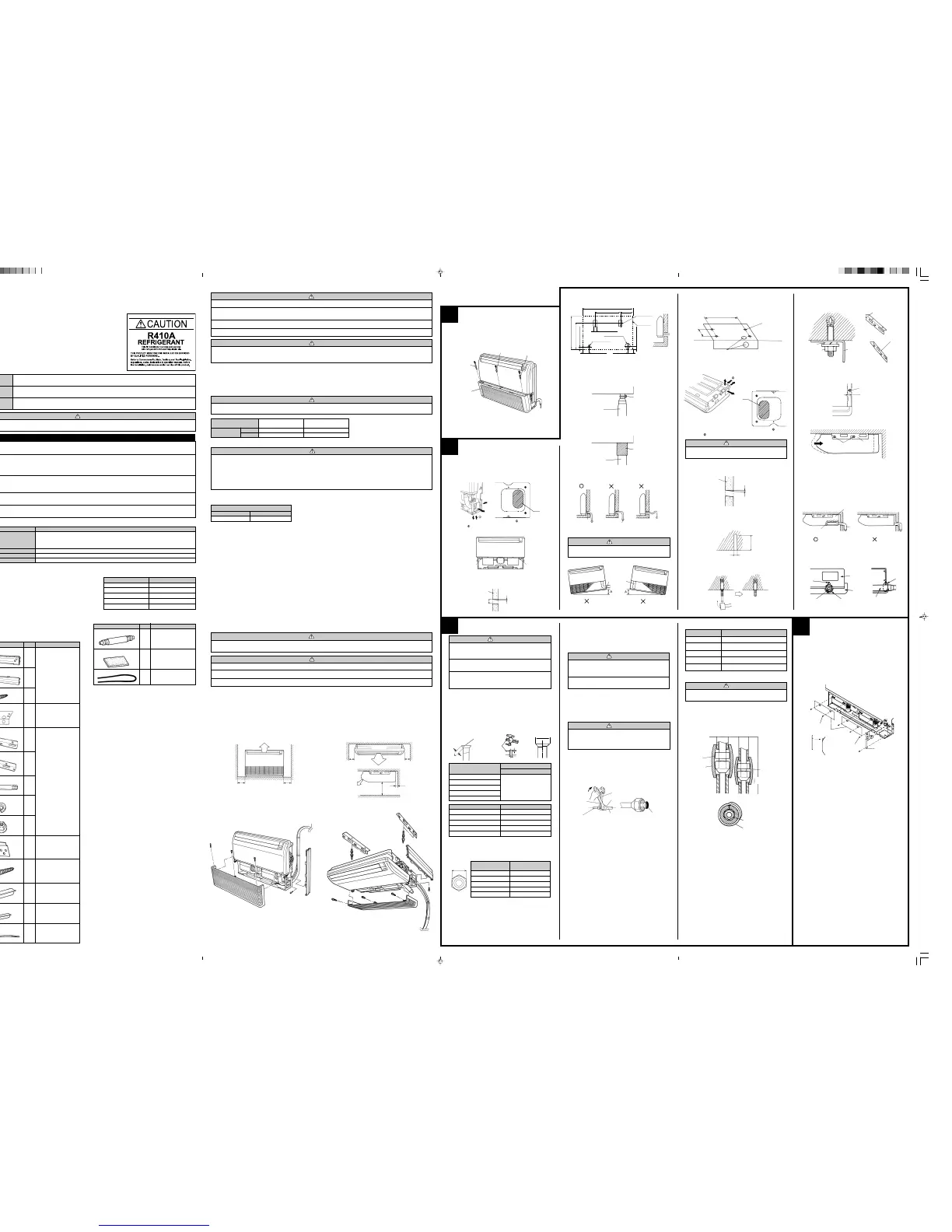